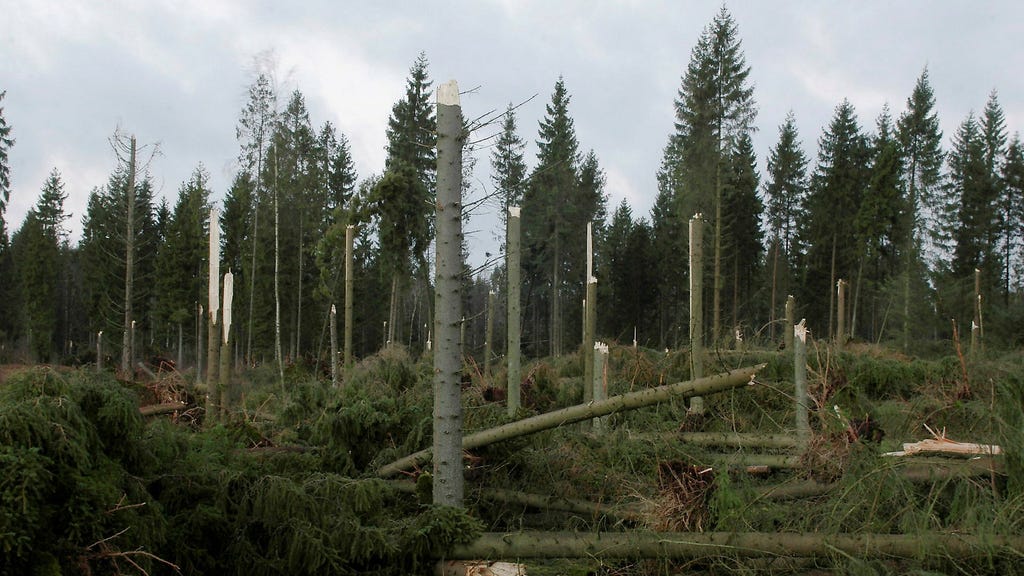The Devastating Legacy of Storm Gudrun: A Retrospective on Sweden’s Tempestuous Trial
In the chilling aftermath of Storm Gudrun, which ravaged Sweden in January 2005, a scene of utter devastation unfolded. The once-familiar landscape was drastically altered, bearing the profound scars of nature’s fury. Around 70 million cubic meters of forest lay splintered and broken, an area equivalent to a year’s worth of national logging concentrated within a small region. Roads were rendered impassable, severing vital lifelines. Thousands were plunged into darkness and isolation, deprived of electricity and telephone communication. The railway network ground to a halt, and the nation reeled in shock and disbelief. Tragically, several lives were lost in the storm’s wake, marking Gudrun as one of the most catastrophic natural disasters in Sweden’s history. Professor Kristina Blennow, a specialist in landscape planning at the Swedish University of Agricultural Sciences, vividly recalls the crisis that engulfed the nation, a chaotic aftermath that persisted for months, leaving many struggling to rebuild their lives and livelihoods.
The impact of Gudrun remains starkly visible in the Swedish landscape even today. The sheer scale of forest destruction means that nature’s recovery will be a long and arduous process, estimated to span approximately 70 years – a lifetime for many. The storm disproportionately affected spruce trees, highlighting the vulnerability of monoculture forestry. For numerous forest owners, Gudrun was a personal catastrophe, wiping out years of investment and disrupting their livelihoods. The event served as a brutal wake-up call, forcing a reassessment of forestry practices and sparking a drive towards climate adaptation. Lennart Svensson, a forest management specialist at the Swedish Forest Agency, emphasizes the profound shift in approach that Gudrun triggered. The storm underscored the urgent need for preventive measures to mitigate future damage, and this has led to a greater focus on diversifying forests, promoting mixed stands, and adopting alternative forestry methods like continuous cover forestry.
The widespread destruction wrought by Gudrun exposed vulnerabilities in Sweden’s infrastructure and preparedness. The storm disrupted essential services, crippled communication networks, and left many stranded. This experience served as a catalyst for significant improvements in disaster preparedness and resilience. Jan-Olof Olsson, an expert in civil contingencies at the Swedish Civil Contingencies Agency (MSB), notes that the nation is far better equipped to handle such events today than it was two decades ago. Gudrun, he argues, has been instrumental in raising awareness at the societal level and fostering improved forecasting, inter-agency collaboration, and geographically targeted response strategies, allowing for focused resource allocation and prioritization.
One of the most significant advancements since Gudrun has been the strengthening of critical infrastructure. Telephone and electricity networks have undergone substantial upgrades, making them more robust and resistant to disruptions. This enhanced resilience aims to minimize the widespread outages that plagued the aftermath of the storm. While considerable progress has been made at the national level, Olsson points out that many individual entities still have work to do in terms of their own crisis preparedness. He emphasizes the need for organizations providing essential services to have contingency plans in place for scenarios where infrastructure fails. This proactive approach, favoring "just in case" over "just in time," is crucial for maintaining essential functions during emergencies.
The recovery from Storm Gudrun has been a protracted process, demanding substantial resources, resilience, and adaptation. The economic impact of the storm was significant, affecting forestry, infrastructure, and various industries. The loss of timber resources alone represented a considerable financial blow, impacting the livelihoods of countless individuals and communities. The disruption to transportation and communication networks further compounded the economic challenges, hindering recovery efforts. Beyond the immediate financial consequences, Gudrun also had social and psychological impacts. The trauma of the storm, the loss of homes and livelihoods, and the prolonged disruption to daily life left lasting emotional scars on many affected communities.
The lessons learned from Gudrun have been invaluable in shaping Sweden’s approach to disaster preparedness and resilience. The storm highlighted the importance of proactive measures, robust infrastructure, and effective communication. The experience underscored the need for contingency plans and the crucial role of inter-agency collaboration in coordinating response efforts. As climate change increases the likelihood of extreme weather events, the legacy of Gudrun serves as a potent reminder of the need for ongoing vigilance and proactive adaptation strategies. The storm’s lasting impact on the Swedish landscape is a poignant testament to the power of nature and the enduring need for human resilience in the face of adversity. It also underscores the importance of learning from past disasters to better prepare for the challenges that lie ahead.














